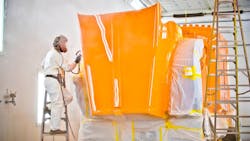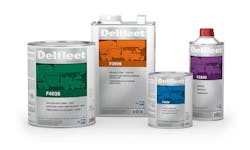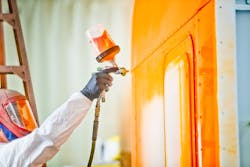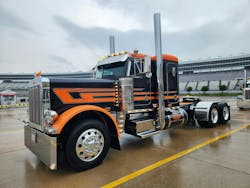How to choose the right paint for your fleet
In this article, you'll learn about:
- How to prepare a truck for painting
- How to select the right paint for your needs
- How care and maintenance will help your paint last longer
For more on painting and collision:
Whether you are managing five trucks or five thousand, selecting the right paint for a heavy-duty truck fleet greatly influences vehicle durability, aesthetics, and upkeep expenses. Commercial body shops and fleet owners should know that using the original equipment finish isn’t mandatory for repair work, as many approved and qualified suppliers offer excellent refinishing options for fleets and individual trucks.
Fleet owners must make well-informed paint choices to ensure their vehicles perform optimally and last longer. Consider these tips when choosing the right paint for your heavy-duty truck fleet.
Understand fleet needs
To make an informed decision, fleet managers must first understand their specific needs.
Color requirements: The fleet’s range and intricacy of colors determine the right paint system. Fleet color needs vary significantly based on branding goals. For example, some companies employ limited colors, such as blue and white. Other fleets might necessitate a wider spectrum, including precise matches to specific car manufacturers’ colors.
For fleets with extensive color needs, including pearlescent or metallic finishes, it’s best to opt for paint systems that offer excellent color matching and a diverse array of options.
Durability: Durability remains key when selecting paint for your fleet. Fleet owners need paint that maintains high gloss retention to ensure their vehicles continue to look polished. The paint should also withstand chips, scratches, and corrosion to protect vehicles from daily wear and tear. Since fleet vehicles often act as moving advertisements, maintaining a clean, rust-free finish projects a professional image.
Life of the vehicle: Consider how long the paint needs to last. If a vehicle only needs to look good for a few years before being resold, a different paint system may be required than one that must endure harsh conditions for longer.
VOC regulations: Volatile organic compounds (VOCs) pose environmental challenges, and fleet owners need to comply with related regulations. If your fleet must adhere to ultra-low VOC standards, choose paint systems that meet these requirements. Some paint systems excel at minimizing VOC emissions while still providing high performance. Heavy-duty truck painters value these systems for their ease of application, superior look, and easier sanding and buffing processes.
Surface preparation
Proper surface preparation remains critical to achieving a durable, professional paint finish. Before applying the paint system, consider these key steps:
Clean: Remove all dirt, grease, and contaminants using appropriate cleaning products. Residue can prevent adhesion and lead to defects in the final finish.
Repair damages: Address any dents, chips, or scratches on the vehicle before priming. Filling and leveling damaged areas ensures a seamless finish.
Sanding: Smooth out imperfections by sanding the surface to ensure uniform paint application. Use the appropriate grit sandpaper to achieve a consistent texture.
Prime: Apply a high-quality primer to promote paint adhesion and protect the underlying surface from corrosion. Allow adequate drying and curing times before applying the topcoat. Follow the recommendations listed on the specific product data sheets (primer, color, and clear) for mixing, application, and dry times.
Proper preparation sets the foundation for a durable and high-performing paint finish, ensuring long-lasting protection and appearance.
Evaluate warranties and support services
Fleet owners should also consider the type of warranty and the level of supplier support offered by the paint system. Different paint systems have varying warranties, influencing long-term maintenance costs and the fleet’s resale value. Several approved and qualified suppliers can provide refinishing options for your fleet and for individual trucks. Additionally, assess the paint system’s availability and range of distribution. Ensure your supplier can reliably meet your fleet’s needs without delay. Reliable local distribution is essential for maintaining operational efficiency.
Also, consider the supplier’s level of technical support. Good technical support can help with product application, troubleshooting, and ongoing maintenance, ensuring that the paint system performs well and lasts. A supplier with strong support services can quickly resolve any issues, reducing downtime and increasing fleet productivity.
Choose a comprehensive solutions partner
Selecting the right partner for your fleet’s paint and protection needs can greatly enhance operational efficiency and brand integrity. Consider these three key aspects:
- Advanced color matching: Identifying a paint supplier with consistent and accurate color-matching capabilities remains crucial for maintaining a professional fleet appearance. Advanced color-matching technologies ensure precise color consistency across any fleet size. These technologies and color standard decks provide reliable and accurate color applications. Utilizing these resources helps maintain brand integrity and visual appeal across the entire fleet.
- Protection products: Fleet owners gain from working with suppliers who offer a broad range of products and services. Their all-in-one approach simplifies the procurement process and ensures uniformity across the fleet. Collaborate with a supplier that provides high-quality paint systems and related products, such as gravel and chip guards, to offer complete fleet maintenance and coating protection solutions.
- Paint line studies: Regularly evaluating and optimizing paint processes can boost paint operations’ productivity, quality, and profitability. A paint process line study by a coatings partner delivers invaluable third-party insights and recommendations by examining equipment, materials, and methodologies to pinpoint improvement areas. Whether it’s refining prep and painting procedures, cutting material usage, or improving work quality, changes implemented after such studies have significantly increased productivity.
Maintenance and care
To maximize the longevity and appearance of your fleet’s paint finish, ongoing maintenance is essential:
- Regular washing: Wash vehicles frequently to remove dirt, road salts, and other contaminants that can damage the paint over time. Use non-abrasive cleaners and soft brushes to avoid scratches.
- Inspect for damage: Regularly check for chips, scratches, or corrosion, and address them promptly to prevent further damage. Touch-up paint can help maintain a professional finish.
- Avoid harsh conditions: Whenever possible, minimize exposure to harsh chemicals, prolonged sunlight, or extreme weather conditions that can degrade paint performance.
Proper care and maintenance preserve your fleet’s aesthetic appeal and extend the life of the paint, ensuring a strong return on investment.
Drive ahead
Choosing the right paint for your fleet involves careful consideration of color requirements, surface preparation, durability, VOC regulations, warranties and support services, and maintenance. By partnering with reliable suppliers and leveraging advanced color-matching technologies, fleet owners can ensure their vehicles maintain a professional appearance and perform well over time. Regularly evaluating and optimizing paint processes further enhances productivity and profitability, providing the best outcomes for your fleet.
About the Author

Mike Sherman
Mike Sherman is the PPG National Account Manager for Fleet and Truck, Commercial Coatings. With more than 24 years of experience in commercial coatings, he offers a wealth of expertise and innovative solutions to meet the diverse needs of our customers. PPG commercial coatings are designed to provide superior protection and performance across various industries. To learn more about PPG commercial coatings and how they can benefit your business, visit here.




